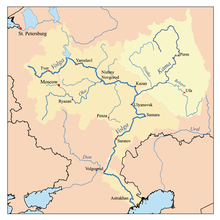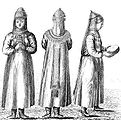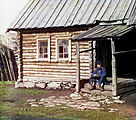Bashkirs
This article needs additional citations for verification. (August 2009) |
 | |
| Regions with significant populations | |
|---|---|
| Russia: 1,673,389 (2002)[1] Uzbekistan: 400 | |
| Languages | |
| Bashkir, Russian | |
| Religion | |
| Predominatly Sunni Islam | |
| Related ethnic groups | |
| Other Turkic peoples |
The Bashkirs (Bashkir: Башҡорттар) are Turkic people indigenous to Bashkortostan, Russia. Groups of Bashkirs also live in the republic of Tatarstan, as well as in Perm Krai and Chelyabinsk, Orenburg, Kurgan, Sverdlovsk, Samara, and Saratov Oblasts of Russia.
Overview
Bashkirs are concentrated on the slopes and confines of the southern Ural Mountains and the neighboring plains. They speak the Kypchak-based Bashkir language, a close relative of the Tatar language. Most Bashkirs also speak Russian: some as a second language, and some as their first language, regarding Bashkir as a language spoken by their grandparents.
History

The name Bashkir is recorded for the first time at the beginning of the 10th century in the writings of the Arab writer ibn Fadlan, who, in describing his travels among the Volga Bulgarians, mentions the Bashkirs as a warlike and idolatrous race. According to ibn Fadlan, the Bashkirs worshiped Tengriism. At that time, Bashkirs lived as nomadic cattle breeders. Until the 13th century they occupied the territories between the Volga and Kama Rivers and the Urals.
The first European sources to mention the Bashkirs are the works of Joannes de Plano Carpini and William of Rubruquis. These travellers, who fell in with Bashkir tribes in the upper parts of the Ural River, called them Pascatir or Bastarci, and asserted that they spoke the same language as the Hungarians.
According to medieval sources, until the arrival of the Mongols in the middle of the 13th century, the Bashkirs were a strong and independent people, troublesome to their neighbors: the Volga Bulgarians and the Petchenegs, but by the time of the downfall of the Khanate of Kazan in 1552 they had dissolved into a number of weak tribes. They were converted to Islam by the Volga Bulgarians in the XIII century.
In 1556, they voluntarily recognized the supremacy of Russia, which in consequence founded the city of Ufa in 1574.
In 1676, the Bashkirs rebelled under a leader named Seit, and the Russian army had great difficulties in ending the rebellion. The Bashkirs rose again in 1707, under Aldar and Kûsyom, on account of ill-treatment by the Russian officials. The third insurrection occurred in 1735, at the time of the foundation of Orenburg, and it lasted for six years.
In 1774, the Bashkirs, under the leadership of Salavat Yulayev, supported Pugachev's rebellion.
In 1786, the Bashkirs achieved tax-free status; and in 1798 Russia formed an irregular Bashkir army from among them. Residual land ownership disputes continued.
Russian Conquest and the Bashkir War of 1735–1740

The Bashkirs lived in a triangular area bounded roughly by the Kama River on the northwest, the Samara River on the south and the upper Ural and Tobol Rivers on the east side of the Urals. They had held the land since at least the time of Ibn Fadlan (921 AD). They were mostly nomadic, with some farming in the north and along the Urals. They were never united under their own Khan or Beg, which meant that they were not a military threat to their better-organized neighbors, but they could be quite troublesome as raiders. After about 1240 they paid tribute to the Mongols. When the Golden Horde broke up Bashkiria was divided into three 'dorogas' ('doroga' here comes from a Tatar word for tax collector or tax district). The Nogai Doroga on the south paid tribute to the Nogai Horde, the Kazan Doroga to the Khanate of Kazan and the Siberian Doroga to the Khanate of Sibir. The Siberian Doroga extended west of the Urals and took in the area north of Ufa.
After the Russians conquered Kazan (1552) and Sibir (1582) the Bashkirs began to pay tribute to Moscow. Tribute was light and collected by clan elders, so there was no real Russian administration. Both Russians and non-Russians began to move into the Bashkir country. The 'Teptiars' paid rent to the Bashkirs while the 'Bobyls' were squatters. The 'Mescheryaks' were exempt from Russian tribute in return for military service. Ufa was founded in the center of the Bashkir country in 1574 (Donnelly says 1586). The three dorogas were kept and a fourth, the Osinsk Doroga, was added to the west of the Siberian Doroga. In 1652-57 the Trans-Kama Line of forts was built from Bely Yar on the Volga, along the Bolshoy Cheremshan River, to Menzelinsk near the Kama between the mouths of the Belaya River and Vyatka River. This cut off a small northwestern area of Bashkiria which was placed under regular Russian administration. In 1732 work was begun to extend the line southeast to the Samara bend, but this was aborted by the Bashkir War. In the 1630s the Kalmyks replaced the Nogais to the south of Bashkiria. The Bashkirs rebelled in 1662-64 and 1675-83 (under Seyid Sadir or 'Seit Sadurov') and 1705-11.
From at least the time of Peter the Great there had been talk of pushing southeast toward Persia and India. Ivan Kirillov drew up a plan to build a fort to be called Orenburg at Orsk at the confluence of the Or River and the Ural River southeast of the Urals where the Bashkir, Kalmyk and Kazakh lands join. (Work was started at Orsk in 1735, but by 1743 'Orenburg' was moved about 250km west to its present location.) The next planned step was to build a fort on the Aral Sea. This would involve crossing the Bashkir country and then the lands of the Kazakh Lesser Horde, some of whom had recently offered a nominal submission. Kirillov's plan was approved on May 1, 1734 and he was placed in command. He was warned that this would provoke a Bashkir rebellion, but the warnings were ignored. He left Ufa with 2,500 men in 1735 and fighting started on the first of July. The war consisted of many small raids and complex troop movements, so it cannot be easily summarized. For example: In the spring of 1736 Kirillov burned 200 villages, killed 700 in battle and executed 158. An expedition of 773 men left Orenburg in November and lost 500 from cold and hunger. At Seiantusa it was planned to massacre the Russians in their sleep, but the surprise failed. One thousand villagers, including women and children, were put to the sword and another 500 driven into a storehouse and burned to death. Raiding parties then went out and burned about 50 villages and killed another 2,000. Eight thousand Bashkirs attacked a Russian camp and killed 158, losing 40 killed and three prisoners who were promptly hanged. Rebellious Bashkirs raided loyal Bashkirs. Leaders who submitted were sometimes fined one horse per household and sometimes hanged. And so on. Bashkirs fought on both sides (40% of 'Russian' troops in 1740). Numerous leaders rose and fell. The oddest was Karasakal or Blackbeard who pretended to have 82,000 men on the Aral Sea and had his followers proclaim him 'Khan of Bashkiria'. His nose had been partly cut off and he had only one ear. The Kazakhs of the Little Horde intervened on the Russian side, then switched to the Bashkirs and then withdrew. Kirillov died of disease during the war and there were several changes of commander. All this was at the time of Empress Elizabeth of Russia and the Russo-Turkish War (1735–1739).
Although the history of the Bashkir War cannot be easily summarized, its results can be.
- The goal of expanding into Central Asia had to be abandoned to deal with the Bashkir problem.
- Bashkiria was pacified in 1735-1740.
- Orenburg was established.
- The southern side of Bashkiria was fenced off by the Orenburg Line of forts. It ran from Samara on the Volga east up the Samara River to its headwaters, crossed to the middle Ural River and followed it east and then north on the east side of the Urals and went east down the Uy River to Ust-Uisk on the Tobol River where it connected to the ill-defined 'Siberian Line' along the forest-steppe boundary.
- In 1740 a report was made of Bashkir loses. It gave: Killed:16,893, Sent to Baltic regiments and fleet: 3,236, Women and children distributed (presumably as serfs): 8,382, Grand Total: 28,511. Fines: Horses: 12,283, Cattle and Sheep: 6,076, Money: 9,828 rubles. Villages destroyed: 696. As this was compiled from army reports it excludes losses from irregular raiding, hunger, disease and cold. All this was from an estimated Bashkir population of 100,000
Culture
Some Bashkirs traditionally practiced agriculture, cattle-rearing and bee-keeping. The nomadic Bashkirs wandered either the mountains or the steppes, herding cattle.
Bashkir national dishes include a kind of gruel called öyrä and a cheese named qorot.
Famous Bashkirs
- Salawat Yulayev
- Zeki Velidi Togan
- Yakup Kulmiy
- Murtaza Rakhimov, first president of Bashkortostan
- Elbrus Nigmatullin, a World's Strongest Man athlete
- Gaziz Almukhametov
- Zemfira (Bashkir mother)
- Laysan Utiasheva (Bashkir mother), gymnast
- Yuri Shatunov (Bashkir mother), singer of Laskoviy Mai
Gallery
-
Bashkirs. Michael Bukar, 1872
-
Bashkir wearing the medal that designates him as the Village Elder. Dj. Fisher, 1892
-
Bashkir woman.
-
Two bashkirs horsemen. Aleksander Orłowski 1814
-
Bashkir at home Sergei Mikhailovich Prokudin-Gorskii, 1909—1915
-
Bashkir woman in national costume Sergei Mikhailovich Prokudin-Gorskii, 1909—1915
-
Bashkir switchman near the town Ust-Katav on the Yuryuzan River between Ufa and Cheliabinsk in the Ural Mountain region, Sergei Mikhailovich Prokudin-Gorskii 1910
References
- Alton S. Donnelly, 'The Russian Conquest of Bashkiria 1552-1740', 1968
- J. P. Carpini, Liber Tartarorum, edited under the title Relations des Mongols ou Tartares, by d'Avezac (Paris, 1838).
- Gulielmus de Rubruquis, The Journey of William of Rubruck to the Eastern Parts of the World, translated by V.W. Rockhill (London, 1900).
- Semenoff, Slovar Ross. Imp., s.v.
- Frhn, "De Baskiris", in Mrn. de l'Acad. de St-Pitersbourg (1822).
- Florinsky, in Вестник Европы [Vestnik Evropy] (1874).
- Katarinskij, Dictionnaire Bashkir-Russe (1900).
- http://depts.washington.edu/uwch/silkroad/texts/rubruck.html
- Chisholm, Hugh, ed. (1911). Encyclopædia Britannica (11th ed.). Cambridge University Press.
{{cite encyclopedia}}: Missing or empty|title=(help)
- ^ "Всероссийская перепись населения 2002 года". Retrieved 2009-12-24.
{{cite web}}: Cite has empty unknown parameter:|datepublished=(help)
External links
- History, culture, language of the Bashkirs
- Template:En icon Bashkir folk-tales and legends
- Template:Ru icon Bashkir folk-tales and legends
- Template:Ru icon Bashkir folk tales in Andrey Platonov's recitation, A. Usmanov, ed., (C) Bashkirskie narodnye skazki, Detgiz, 1947. 96 pp., A.K. Bulygin, ed., (C) ImWerden Verlag, München 2005.







